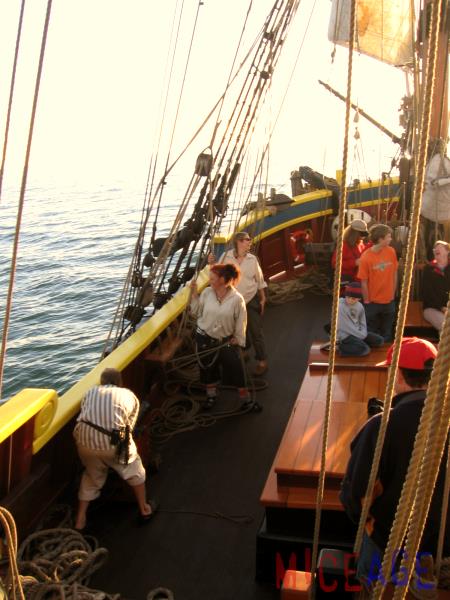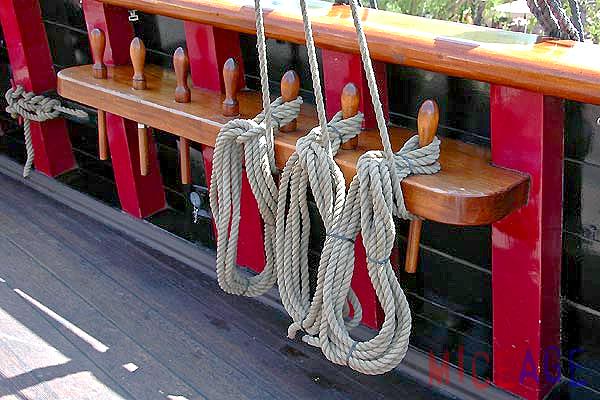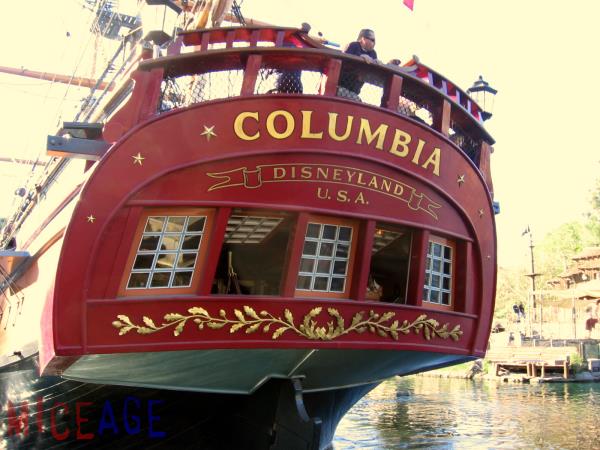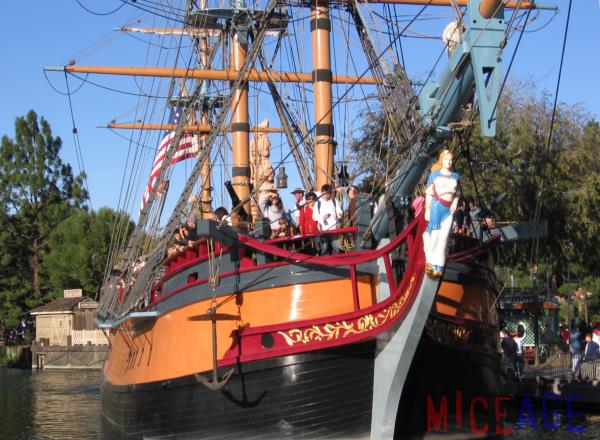| The Columbia Story
(continued)
Instead,
the ship's pin rails use a simple system of organization, so that the
lines and pins are used quite systematically. And not all pins and lines look
the same, either! To the trained eyes, there are numerous clues as to which
line does what. In fact, this system is so efficient, that once a sailor learns
the pin system by heart on one ship, he will be able to sail another ship with
very minimal training.
Take
this demonstration of the system's efficiency. New deckhands on the Lady
Washington are usually given a quick game of "pin chase"--a line
is named (could be as plain as "fore t'gallant halyard" or as long as
"starboard main topmast staysail tack uphaul") and the first trainee
to find the correct pin corresponding to this line wins. Of approximately 180
lines on the Lady, the success rate of this game is very high, even if
the trainee had been on board for just a few days.

Sailors adjusting the running rigging on board Lady Washington. Photo
courtesy Preston Nirattisai.
Veteran
sailors take this game up another level by blindfolding each other. While
they're all able to find the lines, it's more amusing to watch each of them
trip over the deck.
So,
does Disney's Columbia employ this accurate pin rail system, or did they
just dump all the lines to whichever pin? While I did not get to personally
verify all the pins' placement, what I did find was quite encouraging. Most of
the lines are more or less where I expected them to be. Some compromises are
made for the sake of, I assume, the Fastasmic! stunts,
and the number of lines are simplified. But for a detail such that they could
have dumped all the lines anywhere and most guests would not notice, Disney
comes through once again in the detailing department.

One of Columbia's
pin rails. The pins themselves are called "belaying pins," and could be swung
as weapons in close combat. Photo courtesy Matt Walker.
But if you try to "operate" these pins on the Columbia, you'll
find that they're permanently "screwed in," rendering them rather
useless. Nevertheless, the details are there.
Colors
Disney's Columbia is mainly black and brown, with trim of red, blue, and
gold. For the most, this is reasonably accurate to history, though the hull
brown might be an attempt at recreating natural wood color. The original Columbia
might have employed the same color scheme (plus natural wooden hull), but to a
lesser extents.
Merchant ships used colors for two reasons. First, painting helps protect the
wood from the environment. Second--and just as important--colors help these ships
stand out from warships, which were painted in a very
muted palette.
Although Disney's Columbia might have the correct colors, the colors are
not used in all the correct places, so you would not see yards and spars
painted blue in 1787. What's bothersome is the very liberal use of red, blue,
and gold trim. These colors were very expensive in 1780s, and would have
been used very sparingly to save cost.

The bright red may have been a little too extravagant for the real Columbia,
but looks just fine here. Photo courtesy Preston Nirattisai.
The bright colors were instead concentrated on the transom--the end of the ship
and generally the most decorative part. The original Lady Washington also probably
did not use yellow to such extent that you see today. Instead, those parts you
see that are "yellow" were most likely left in natural wood, and then
oiled to protect them.

The Lady Washington's transom features a more-muted palette. Photo
courtesy Preston Nirattisai.

Columbia shows off her colors in the bright afternoon sunlight. Photo
courtesy Preston Nirattisai.

Again, Lady Washington's colors are not quite as bright as her
theme-park sister ship. Photo courtesy Preston Nirattisai.
We continue the comparison between the two ships in
the next installment
of this series.
|
